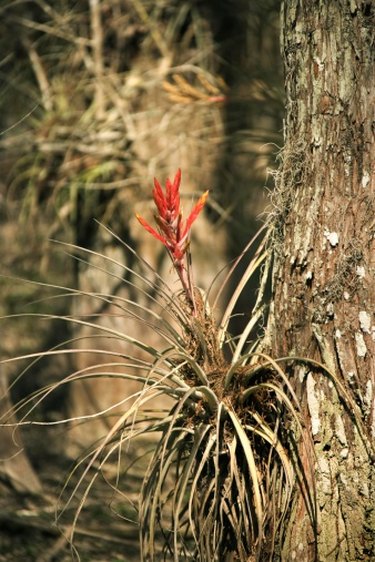
Plants that live on other plants are either epiphytes or parasites. Epiphytes use other plants, like tall trees, to help them gain access to light, moisture and needed nutrients. The epiphytes attach themselves to a stem or branch, but they do not feed on the host plant. Parasitic plants attach themselves, feed off the host plant and rob it of light, water or nutrients. Both types can hurt the host plant but parasitic plants can do much more damage than epiphytes.
Epiphytes
Video of the Day
Epiphytes grow on host plants and on other structures as well. Some well-known epiphytes are the bromeliads and orchids of the tropics. They get water and nutrients from the air instead of from soil like most other plants. The Spanish moss that hangs in sheets off trees in many areas of the southern U.S. is an epiphyte from the Tillandsia genus. In cooler climates, mosses and ferns are the primary epiphytes.
Video of the Day
Parasitic Plants
Parasitic plants derive some kind of sustenance from the host plant or tree. The roots penetrate the host plant's bark and feed off the nutrition flowing in the xylem and phloem, the pathways that transport nutrition and water through plants. Some parasitic plants can't even produce chlorophyll, an essential food-making part of a cell. Dodder, a twining plant in the morning glory family, wraps itself around host plants. Mistletoe, a common Christmas decoration, is a parasitic plant that acts like an epiphyte and primarily attacks oak trees.
Vines
Vines can live in trees but have roots in the soil. Vines use trees for support, climbing to the canopy to gain access to the light. They can interfere with a tree's ability to form its own food or maintain its structural strength. Some vines are considered invasive species because of their aggressive growth habits. Hedera (English ivy) and kudzu (morning glory family) climb up trees and limit the tree's food production. Hedera also forms its seeds in the light of the sun.
Other Plants
Trees may form natural pockets, giving plants a protected place to grow. A tree may have a rotten spot, formed an indentation or branched in a way so that a pocket was created. Leaves and needles fall into those nooks and rot, eventually creating soil. Seeds then fall into this soil and germinate. Often, grasses and small weeds or plants can be seen growing in the crotch of a tree.